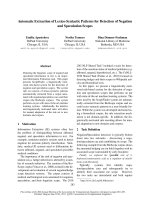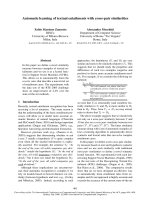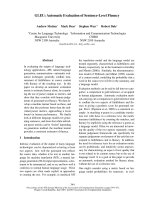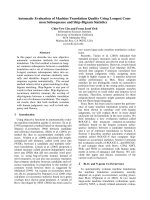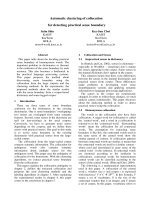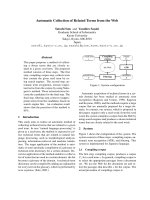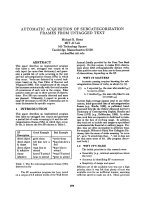Báo cáo khoa học: "Automatic Detection of Syllable Boundaries Combining the Advantages of Treebank and Bracketed Corpora Training" docx
Bạn đang xem bản rút gọn của tài liệu. Xem và tải ngay bản đầy đủ của tài liệu tại đây (58.13 KB, 8 trang )
Automatic Detection of Syllable Boundaries Combining the Advantages
of Treebank and Bracketed Corpora Training
Karin Müller
Institut für Maschinelle Sprachverarbeitung
University of Stuttgart
Azenbergstrasse 12
D-70174 Stuttgart, Germany
Abstract
An approach to automatic detection of
syllable boundaries is presented. We
demonstrate the use of several manu-
ally constructed grammars trained with
a novel algorithm combining the advan-
tages of treebank and bracketed corpora
training. We investigate the effect of
the training corpus size on the perfor-
mance of our system. The evaluation
shows that a hand-written grammar per-
forms better on finding syllable bound-
aries than does a treebank grammar.
1 Introduction
In this paper we present an approach to super-
vised learning and automatic detection of sylla-
ble boundaries. The primary goal of the paper
is to demonstrate that under certain conditions
treebank and bracketed corpora training can be
combined by exploiting the advantages of the two
methods. Treebank training provides a method of
unambiguous analyses whereas bracketed corpora
training has the advantage that linguistic knowl-
edge can be used to write linguistically motivated
grammars.
In text-to-speech (TTS) systems, like those de-
scribed in Sproat (1998), the correct pronuncia-
tion of unknown or novel words is one of the
biggest problems. In many TTS systems large
pronunciation dictionaries are used. However,
the lexicons are finite and every natural language
has productive word formation processes. The
German language for example is known for its
extensive use of compounds. A TTS system
needs a module where the words converted from
graphemes to phonemes are syllabified before
they can be further processed to speech. The
placement of the correct syllable boundary is es-
sential for the application of phonological rules
(Kahn, 1976; Blevins, 1995). Our approach of-
fers a machine learning algorithm for predicting
syllable boundaries.
Our method builds on two resources. The
first resource is a series of context-free gram-
mars (CFG) which are either constructed manu-
ally or extracted automatically (in the case of the
treebank grammar) to predict syllable boundaries.
The different grammars are described in section
4. The second resource is a novel algorithm that
aims to combine the advantages of treebank and
bracketed corpora training. The obtained proba-
bilistic context-free grammars are evaluated on a
test corpus. We also investigate the influence of
the size of the training corpus on the performance
of our system.
The evaluation shows that adding linguistic in-
formation to the grammars increases the accuracy
of our models. For instance, we coded the knowl-
edge that (i) consonants in the onset and coda are
restricted in their distribution, and (ii) the position
inside of the word plays an important role. Fur-
thermore, linguistically motivated grammars only
need a small size of training corpus to achieve
high accuracy and even out-perform the treebank
grammar trained on the largest training corpus.
The remainder of the paper is organized as fol-
lows. Section 2 refers to treebank training. In
section 3 we introduce the combination of tree-
[
f
On
Onset
O
Nucleus
R
Cod
Coda
Syl
][
d
On
Onset
@
Nucleus
Syl
][
R
On
Onset
U
Nucleus
N
Cod
Coda
Syl
]
Word
Figure 1: Example tree in the training phase
bank and bracketed corpora training. In section
4 we describe the grammars and experiments for
German data. Section 5 is dedicated to evaluation
and in section 6 we discuss our results.
2 Treebank Training (TT) and
Bracketed Corpora Training (BCT)
Treebank grammars are context-free grammars
(CFG) that are directly read from production rules
of a hand-parsed treebank. The probability of
each rule is assigned by observing how often each
rule was used in the training corpus, yielding a
probabilistic context-free grammar. In syntax it is
a commonly used method, e.g. Charniak (1996)
extracted a treebank grammar from the Penn Wall
Street Journal. The advantages of treebank train-
ing are the simple procedure, and the good results
which are due to the fact that for each word that
appears in the training corpus there is only one
possible analysis. The disadvantage is that gram-
mars which are read off a treebank are dependent
on the quality of the treebank. There is no free-
dom of putting more information into the gram-
mar.
Bracketed Corpora Training introduced by
Pereira and Schabes (1992) employs a context-
free grammar and a training corpus, which is par-
tially tagged with brackets. The probability of a
rule is inferred by an iterative training procedure
with an extended version of the inside-outside al-
gorithm. However, only those analyses are con-
sidered that meet the tagged brackets (here sylla-
ble brackets). Usually the context-free grammars
generate more than one analysis. BCT reduces
the large number of analyses. We utilize a spe-
cial case of BCT where the number of analyses is
always 1.
Treebank
Training:
Application:
New Algorithm:
Grammar
Transformation
Analysis Grammar without Brackets
Training Grammar with Brackets
(manually constructed)
(extracted from CELEX)
Input with Bracket
Input without Brackets
Figure 2: The novel algorithm that we capitalize
on in this paper
3 Combining the Advantages of TT and
BCT
Our method used for the experiments is based
on treebank training as well as bracketed corpora
training. The main idea is that there are large pro-
nunciation dictionaries that provide information
about how words are transcribed and how they
are syllabified. We want to exploit this linguis-
tic knowledge that was put into these dictionar-
ies. For our experiments we employ a pronun-
ciation dictionary, CELEX (Baayen et al. (1993))
that provides syllable boundaries, our so-called
treebank. We use the syllable boundaries as
brackets. The advantage of BCT can be uti-
lized: writing grammars using linguistic knowl-
edge. With our method a special case of BCT is
applied where the brackets in combination with a
manually constructed grammar guarantee a single
analysis in the training step with maximal linguis-
tic information.
Figure 2 depicts our new algorithm. We man-
ually construct different linguistically motivated
context-free grammars with brackets marking the
syllable boundaries. We start with a simple gram-
mar and continue to add more linguistic informa-
tion to the advanced grammars. The input of the
grammars is a bracketed corpus that was extracted
from the pronunciation dictionary CELEX. In a
treebank training step we obtain a probabilistic
context-free grammar (PCFG) by observing how
often each rule was used in the training corpus.
The brackets of the input guarantee an unam-
bigous analysis of each word. Thus, we can apply
the formula of treebank training given by (Char-
(1.1) 0.1774 Word Syl
(1.2) 0.5107 Word Syl Syl
(1.3) 0.1997 Word Syl Syl Syl
(1.4) 0.4915 Syl Onset Nucleus Coda
(1.5) 0.3591 Syl Onset Nucleus
(1.6) 0.0716 Syl Nucleus Coda
(1.7) 0.0776 Syl Nucleus
(1.8) 0.9045 Onset On
(1.9) 0.0918 Onset On On
(1.10) 0.0036 Onset On On On
(1.11) 0.0312 Nucleus O
(1.12) 0.3286 Nucleus @
(1.13) 0.0345 Nucleus U
(1.14) 0.8295 Coda Cod
(1.15) 0.1646 Coda Cod Cod
(1.16) 0.0052 Coda Cod Cod Cod
(1.17) 0.0472 On f
(1.18) 0.0744 On d
(1.19) 0.2087 Cod R
(1.20) 0.0271 Cod N
Figure 3: Grammar fragment after the training
niak, 1996): if r is a rule, let
be the number of
times
occurred in the parsed corpus and be
the non-terminal that
expands, then the proba-
bility assigned to
is given by
We then transform the PCFG by dropping the
brackets in the rules resulting in an analysis
grammar. The bracketless analysis grammar is
used for parsing the input without brackets; i.e.,
the phoneme strings are parsed and the syllable
boundaries are extracted from the most proba-
ble parse. We want to exemplify our method by
means of a syllable structure grammar and an ex-
emplary phoneme string.
Grammar. We experimented with a series of
grammars, which are described in details in sec-
tion 4.2. In the following we will exemplify how
the algorithm works. We chose the syllable struc-
ture grammar, which divides a syllable into on-
set, nucleus and coda. The nucleus is obligatory
which can be either a vowel or a diphtong. All
phonemes of a syllable that are on the left-hand
side of the nucleus belong to the onset and the
phonemes on the right-hand side pertain to the
coda. The onset or the coda may be empty. The
context-free grammar fragment in Figure 3 de-
scribes a so called training grammar with brack-
ets.
We use the input word “Forderung” (claim)
fOR d@ RUN in the training step. The unam-
biguous analysis of the input word with the sylla-
ble structure grammar is shown in Figure 1.
Training. In the next step we train the context-
free training grammar. Every grammar rule ap-
pearing in the grammar obtains a probability de-
pending on the frequency of appearance in the
training corpus, yielding a PCFG. A fragment
1
of the syllable structure grammar is shown in Fig-
ure 3 (with the recieved probabilities).
Rules (1.1)-(1.3) show that German disyllabic
words are more probable than monosyllabic and
trisyllabic words in the training corpus of 389000
words. If we look at the syllable structure, then it
is more common that a syllable consists of an on-
set, nucleus, and coda than a syllable comprising
the onset and nucleus; the least probable struc-
ture are syllables with an empty onset, and syl-
lables with empty onset and empty coda. Rules
(1.8)-(1.10) show that simple onsets are preferred
over complex ones, which is also true for codas.
Furthermore, the voiced stop
d is more likely
to appear in the onset than the voiceless fricative
f . Rules (1.19)-(1.20) show the Coda consonants
with descending probability:
R , N .
Grammar transformation. In a further
step we transform the obtained PCFG by drop-
ping all syllable boundaries (brackets). Rules
(1.4)-(1.20) do not change in the fragment of
the syllable structure grammar. However, the
rules (1.1)-(1.3) of the analysis grammar are
affected by the transformation, e.g. the rule
(1.2.) Word
Syl Syl would be transformed
to (1.2.’) Word
Syl Syl, dropping the brackets
Predicting syllable boundaries. Our system
is now able to predict syllable boundaries with the
transformed PCFG and a parser. The input of the
system is a phoneme string without brackets. The
phoneme string
fORd@RUN (claim) gets the
following possible syllabifications according to
the syllable structure grammar:
fO Rd@R UN ,
fO Rd@ RUN , fOR d@R UN , fOR d@ RUN ,
fORd @R UN and fORd @ RUN .
The final step is to choose the most probable
analysis. The subsequent tree depicts the most
probable analysis:
fOR d@ RUN , which is
also the correct analysis with the overall word
probability of 0.5114. The probability of one
1
The grammar was trained on 389000 words
analysis is defined as the product of the prob-
abilities of the grammar rules appearing in the
analysis normalized by the sum of all analysis
probabilities of the given word. The category
“Syl” shows which phonemes belong to the
syllable, it indicates the beginning and the end of
a syllable. The syllable boundaries can be read
off the tree:
fOR [d@ RUN .
f
On
Onset
O
Nucleus
R
Cod
Coda
Syl
d
On
Onset
@
Nucleus
Syl
R
On
Onset
U
Nucleus
N
Cod
Coda
Syl
Word (0.51146)
4 Experiments
We experimented with a series of grammars: the
first grammar, a treebank grammar, was automat-
ically read from the corpus, which describes a syl-
lable consisting of a phoneme sequence. There
are no intermediate levels between the syllable
and the phonemes. The second grammar is a
phoneme grammar where only the number of
phonemes is important. The third grammar is a
consonant-vowel grammar with the linguistic in-
formation that there are consonants and vowels.
The fourth grammar, a syllable structure gram-
mar is enriched with the information that the con-
sonant in the onset and coda are subject to certain
restrictions. The last grammar is a positional syl-
lable structure grammar which expresses that the
consonants of the onset and coda are restricted ac-
cording to the position inside of a word (e.g, ini-
tial, medial, final or monosyllabic). These gram-
mars were trained on different sizes of corpora
and then evaluated. In the following we first intro-
duce the training procedure and then describe the
grammars in details. In section 5 the evaluation
of the system is described.
4.1 Training procedure
We use a part of a German newspaper corpus, the
Stuttgarter Zeitung, consisting of 3 million words
which are divided into 9/10 training and 1/10 test
corpus. In a first step, we look up the words and
their syllabification in a pronunciation dictionary.
The words not appearing in the dictionary are dis-
carded. Furthermore we want to examine the in-
fluence of the size of the training corpus on the
results of the evaluation. Therefore, we split the
training corpus into 9 corpora, where the size of
the corpora increases logarithmically from 4500
to 2.1 million words. These samples of words
serve as input to the training procedure.
In a treebank training step we observe for each
rule in the training grammar how often it is used
for the training corpus. The grammar rules with
their probabilities are transformed into the anal-
ysis grammar by discarding the syllable bound-
aries. The grammar is then used for predicting
syllable boundaries in the test corpus.
4.2 Description of grammars
Treebank grammar. We started with an au-
tomatically generated treebank grammar. The
grammar rules were read from a lexicon. The
number of lexical entries ranged from 250 items
to 64000 items. The grammars obtained start
with 460 rules for the smallest training corpus,
increasing to 6300 rules for the largest training
corpus. The grammar describes that words are
composed of syllables which consist of a string
of phonemes or a single phoneme. The following
table shows the frequencies of some of the rules
of the analysis grammar that are required to
analyze the word
fORd@RUN (claim):
(3.1) 0.1329 Word Syl Syl Syl
(3.2) 0.0012 Syl fOR
(3.3) 0.0075 Syl d@
(3.4) 0.0050 Syl d@R
(3.5) 0.0020 Syl RUN
(3.6) 0.0002 Syl UN
Rule (3.1) describes a word that branches to
three syllables. The rules (3.2)-(3.6) depict that
the syllables comprise different phoneme strings.
For example, the word “Forderung” (claim) can
result in the following two analyses:
fOR
Syl
d@
Syl
RUN
Syl
Word (0.9153)
fOR
Syl
d@R
Syl
UN
Syl
Word (0.0846)
The right tree receives the overall probability of
(0.0846) and the left tree (0.9153), which means
that the word
fORd@RUN would be syllabified:
fOR d@ RUN (which is the correct analysis).
Phoneme grammar. A second grammar is
automatically generated where an abstract level
is introduced. Every input phoneme is tagged
with the phoneme label: P. A syllable consists
of a phoneme sequence, which means that the
number of phonemes and syllables is the decisive
factor for calculating the probability of a word
segmentation (into syllables). The following
table shows a fragment of the analysis grammar
with the rule frequencies. The grammar consists
of 33 rules.
(4.1) 0.4423 Word Syl Syl Syl
(4.2) 0.1506 Syl PP
(4.3) 0.2231 Syl PPP
(4.4) 0.0175 P f
(4.5) 0.0175 P O
(4.6) 0.0175 P R
Rule (4.1) describes a three-syllabic word.
The second and third rule describe that a
three-phonemic syllable is preferred over two-
phonemic syllables. Rules (4.4)-(4.6) show that
P is re-written by the phonemes:
f , O , and R .
The word “Forderung” can be analyzed with the
training grammar as follows (two examples out
of 4375 possible analyses):
f
P
O
P
R
P
Syl
d
P
@
P
Syl
R
P
U
P
N
P
Syl
Word (0.2031)
f
P
Syl
O
P
R
P
Syl
d
P
@
P
R
P
U
P
N
P
Syl
Word (0.0006)
Consonant-vowel grammar. In comparison
with the phoneme grammar, the consonant-
vowel (CV) grammar describes a syllable as a
consonant-vowel-consonant (CVC) sequence
(Clements and Keyser, 1983). The linguistic
knowledge that a syllable must contain a vowel is
added to the CV grammar, which consists of 31
rules.
(5.1) 0.1608 Word Syl
(5.2) 0.3363 Word Syl Syl Syl
(5.3) 0.3385 Syl CV
(5.4) 0.4048 Syl CVC
(5.5) 0.0370 C f
(5.6) 0.0370 C R
(5.7) 0.0333 V O
(5.8) 0.0333 V @
Rule (5.1) shows that a three-syllabic word
is more likely to appear than a mono-syllabic
word (rule (5.2)). A CVC sequence is more
probable than an open CV syllable. The rules
(5.5)-(5.8) depict some consonants and vowels
and their probability. The word “Forderung”
can be analyzed as follows (two examples out of
seven possible analyses):
f
C
O
V
R
C
Syl
d
C
@
V
Syl
R
C
U
V
N
C
Syl
Word (0.6864)
f
C
O
V
R
C
Syl
d
C
@
V
R
C
Syl
U
V
N
C
Syl
Word (0.2166)
The correct analysis (left tree) is more probable
than the wrong one (right tree).
Syllable structure grammar. We added to the
CV grammar the information that there is an on-
set, a nucleus and a coda. This means that the con-
sonants in the onset and in the coda are assigned
different weights. The grammar comprises 1025
rules. The grammar and an example tree was al-
ready introduced in section 3.
Positional syllable structure grammar. Fur-
ther linguistic knowledge is added to the syllable
structure grammar. The grammar differentiate
between monosyllabic words, syllables that occur
in inital, medial, and final position. Furthermore
the syllable structure is defined recursively.
Another difference to the simpler grammar
versions is that the syllable is devided into onset
and rhyme. It is common wisdom that there are
restrictions inside the onset and the coda, which
are the topic of phonotactics. These restrictions
are language specific; e.g., the phoneme sequence
ld is quite frequent in English codas but it
never appears in English onsets. Thus the feature
position of the phonemes in the onset and in the
coda is coded in the grammar, that means for
example that an onset cluster consisting of 3
phonemes are ordered by their position inside of
the cluster, and their position inside of the word,
e.g. On.ini.1 (first onset consonant in an initial
syllable), On.ini.2, On.ini.3. A fragment of the
analysis grammar is shown in the following table:
(6.1) 0.3076 Word Syl.one
(6.2) 0.6923 Word Syl.ini Syl
(6.3) 0.3662 Syl Syl.fin
(6.4) 0.7190 Syl.one
Onset.one Rhyme.one
(6.5) 0.0219 Onset.one On.one.1 On.one.2
(6.6) 0.0215 On.ini.1 f
(6.7) 0.0689 Nucleus.ini O
(6.8) 0.3088 Coda.ini Cod.ini.1
(6.9) 0.0464 Cod.ini.1 R
Rule (6.1) shows a monosyllabic word con-
sisting of one syllable. The second and third
rules describe a bisyllabic word comprising an
initial and a final syllable. The monosyllabic
feature “one” is inherited to the daughter nodes,
here to the onset, nucleus and coda in rule (6.4).
Rule (6.5) depicts an onset that branches into
two onset parts in a monosyllabic word. The
numbers represents the position inside the onset.
The subsequent rule displays the phoneme
f of
an initial onset. In rule (6.7) the nucleus of an
initial syllable consists of the phoneme
O . Rule
(6.8) means that the initial coda only comprises
one consonant, which is re-written by rule (6.9)
to a mono-phonemic coda which consists of
the phoneme
R . The first of the following
two trees recieves a higher overall probabability
than the second one. The correct analysis of
the transcribed word /claim/
fORd@RUN
can be extracted from the most probable tree:
fOR d@ RUN . Note, all other analyses of
fORd@RUN are very unlikely to occur.
f
On.ini.1
Onset.ini
O
Nuc.ini
Nucleus.ini
R
Cod.ini.1
Coda.ini
Syl.ini
d
On.med.1
Onset.med
@
Nuc.med
Nucleus.med
Syl.med
R
On.fin.1
Onset.fin
U
Nuc.fin
Nucleus.fin
N
Cod.fin.1
Coda.fin
Syl.fin
Syl
Syl
Word (0.9165)
f
On.ini.1
Onset.ini
O
Nuc.ini
Nucleus.ini
R
Cod.ini.1
Coda.ini
Syl.ini
d
On.med.1
Onset.med
@
Nuc.med
Nucleus.med
R
Cod.med.1
Coda.med
Syl.med
U
Nuc.fin
Nucleus.fin
N
Cod.fin.1
Coda.fin
Syl.fin
Syl
Syl
Word (0.0834)
5 Evaluation
We split our corpus into a 9/10 training and a 1/10
test corpus resulting in an evaluation (test) corpus
consisting of 242047 words.
Our test corpus is available on the World Wide
Web
2
. There are two different features that char-
acterize our test corpus: (i) the number of un-
known words in the test corpus, (ii) and the num-
ber of words with a certain number of syllables.
The proportion of the unknown words is depicted
in Figure 4. The percentage of unknown words
is almost 100% for the smallest training corpus,
decreasing to about 5% for the largest training
corpus. The “slow” decrease of the number of
unknown words of the test corpus is due to both
the high amount of test data (242047 items) and
the “slightly” growing size of the training cor-
pus. If the training corpus increases, the num-
ber of words that have not been seen before (un-
known) in the test corpus decreases. Figure 4
shows the distribution of the number of syllables
in the test corpus ranked by the number of sylla-
bles, which is a decreasing function. Almost 50%
of the test corpus consists of monosyllabic words.
If the number of syllables increases, the number
of words decreases.
The test corpus without syllable boundaries,
is processed by a parser (Schmid (2000)) and
the probabilistic context-free grammars sustain-
ing the most probable parse (Viterbi parse) of
each word. We compare the results of the parsing
step with our test corpus (annotated with sylla-
ble boundaries) and compute the accuracy. If the
parser correctly predicts all syllable boundaries of
2
/>0
10
20
30
40
50
60
70
80
90
100
4500 9600 15000 33000 77800 182000 389000 1031000 2120000
percentage of unknown words
size of training corpus
proportion of unknown words in the test corpus: 242047 tokens
"unknown.tok"
0
20000
40000
60000
80000
100000
120000
1-syl 2-syls 3-syls 4-syls 5-syls 6-syls 7-syls 8-syls 9-syls 10-syls 11-syls 12-syls 13-syls
number of words
number of syllables
proportion of number of syllables in the test corpus
"syls"
Figure 4: Unknown words in the test corpus(left); number of syllables in the test corpus (right)
grammars word accuracy
treebank 94.89
phoneme 64.44
CV 93.52
syl structure 94.77
pos. syl structure 96.49
Figure 5: Best accuracy values of the series of
grammars
a word, the accuracy increases. We measure the
so called word accuracy.
The accuracy curves of all grammars are shown
in Figure 6. Comparing the treebank gram-
mar and the simplest linguistic grammar we see
that the accuracy curve of the treebank grammar
monotonically increases, whereas the phoneme
grammar has almost constant accuracy values
(63%). The figure also shows that the simplest
grammar is better than the treebank grammar un-
til the treebank grammar is trained with a cor-
pus size of 77.800. The accuracy of both gram-
mars is about 65% at that point. When the corpus
size exceeds 77800, the performance of the tree-
bank grammar is better than the simplest linguis-
tic grammar. The best treebank grammar reaches
a accuracy of 94.89%. The low accuracy rates
of the treebank grammar trained on small corpora
are due to the high number of syllables that have
not been seen in the training procedure. Figure 6
shows that the CV grammar, the syllable struc-
ture grammar and the positional syllable structure
grammar outperform the treebank grammar by at
least 6% with the second largest training corpus
of about 1 million words. When the corpus size is
doubled, the accuracy of the treebank grammar is
still 1.5% below the positional syllable structure
grammar.
Moreover, the positional syllable structure
grammar only needs a corpus size of 9600 to out-
perform the treebank grammar. Figure 5 is a sum-
mary of the best results of the different grammars
on different corpora sizes.
6 Discussion
We presented an approach to supervised learn-
ing and automatic detection of syllable bound-
aries, combining the advantages of treebank and
bracketed corpora training. The method exploits
the advantages of BCT by using the brackets of
a pronunciation dictionary resulting in an unam-
bigous analysis. Furthermore, a manually con-
structed linguistic grammar admit the use of max-
imal linguistic knowledge. Moreover, the advan-
tage of TT is exploited: a simple estimation pro-
cedure, and a definite analysis of a given phoneme
string. Our approach yields high word accu-
racy with linguistically motivated grammars us-
ing small training corpora, in comparison with the
treebank grammar. The more linguistic knowl-
edge is added to the grammar, the higher the accu-
racy of the grammar is. The best model recieved a
96.4% word accuracy rate (which is a harder cri-
terion than syllable accuracy).
Comparison of the performance with other
systems is difficult: (i) hardly any quantita-
tive syllabification performance data is available
for German; (ii) comparisons across languages
are hard to interpret; (iii) comparisons across
different approaches require cautious interpreta-
tions. Nevertheless we want to refer to sev-
10
20
30
40
50
60
70
80
90
100
4500 9600 15000 33000 77800 182000 389000 1031000 2120000
precision
size of training corpus
overall precision
"treebank.tok"
"phonemes.tok"
"C_V.tok"
"syl_structure.tok"
"ling_pos.tok"
"ling_pos_stress.tok"
80
85
90
95
100
4500 9600 15000 33000 77800 182000 389000 1031000 2120000
precision
size of training corpus
overall precision
"treebank.tok"
"phonemes.tok"
"C_V.tok"
"syl_structure.tok"
"ling_pos.tok"
"ling_pos_stress.tok"
Figure 6: Evaluation of all grammars (left), zoom in (right)
eral approaches that examined the syllabification
task. The most direct point of comparison is the
method presented by Müller (to appear 2001). In
one of her experiments, the standard probabil-
ity model was applied to a syllabification task,
yielding about 89.9% accuracy. However, syl-
lable boundary accuracy is measured and not
word accuracy. Van den Bosch (1997) investi-
gated the syllabification task with five induc-
tive learning algorithms. He reported a gener-
alisation error for words of 2.22% on English
data. However, in German (as well as Dutch
and Scandinavian languages) compounding by
concatenating word forms is an extremely pro-
ductive process. Thus, the syllabification task
is much more difficult in German than in En-
glish. Daelemans and van den Bosch (1992) re-
port a 96% accuracy on finding syllable bound-
aries for Dutch with a backpropagation learning
algorithm. Vroomen et al. (1998) report a sylla-
ble boundary accuracy of 92.6% by measuring the
sonority profile of syllables. Future work is to ap-
ply our method to a variety of other languages.
References
Harald R. Baayen, Richard Piepenbrock, and H. van
Rijn. 1993. The CELEX lexical database—Dutch,
English, German. (Release 1)[CD-ROM]. Philadel-
phia, PA: Linguistic Data Consortium, Univ. Penn-
sylvania.
Juliette Blevins. 1995. The Syllable in Phonological
Theory. In John A. Goldsmith, editor, Handbook of
Phonological Theory, pages 206–244, Blackwell,
Cambridge MA.
Eugene Charniak. 1996. Tree-bank grammars. In
Proceedings of the Thirteenth National Conference
on Artificial Intelligence, AAAI Press/MIT Press,
Menlo Park.
George N Clements and Samuel Jay Keyser. 1983.
CV Phonology. A Generative Theory of the Syllable.
MIT Press, Cambridge, MA.
Walter Daelemans and Antal van den Bosch. 1992.
Generalization performance of backpropagation
learning on a syllabification task. In M.F.J.
Drossaers and A Nijholt, editors, Proceedings of
TWLT3: Connectionism and Natural Language
Processing, pages 27–37, University of Twente.
Daniel Kahn. 1976. Syllable-based Generalizations
in English Phonology. Ph.D. thesis, Massatchusetts
Institute of Technology, MIT.
Karin Müller. to appear 2001. Probabilistic context-
free grammars for syllabification and grapheme-to-
phoneme conversion. In Proc. of the Conference on
Empirical Methods in Natural Language Process-
ing, Pittsburgh, PA.
Fernando Pereira and Yves Schabes. 1992. Inside-
outside reestimation from partially bracketed cor-
pora. In Proceedings of the 30th Annual Meeting of
the Association for Computational Linguistics.
Helmut Schmid. 2000. LoPar. Design and Implemen-
tation. [ />gramotron/SOFTWARE/LoPar-en.html].
Richard Sproat, editor. 1998. Multilingual Text-to-
Speech Synthesis: The Bell Labs Approach. Kluwer
Academic, Dordrecht.
Antal Van den Bosch. 1997. Learning to Pronounce
Written Words: A Study in Inductive Language
Learning. Ph.D. thesis, Univ. Maastricht, Maas-
tricht, The Netherlands.
Jean Vroomen, Antal van den Bosch, and Beatrice
de Gelder. 1998. A Connectionist Model for Boot-
strap Learning of Syllabic Structure. 13:2/3:193–
220.

